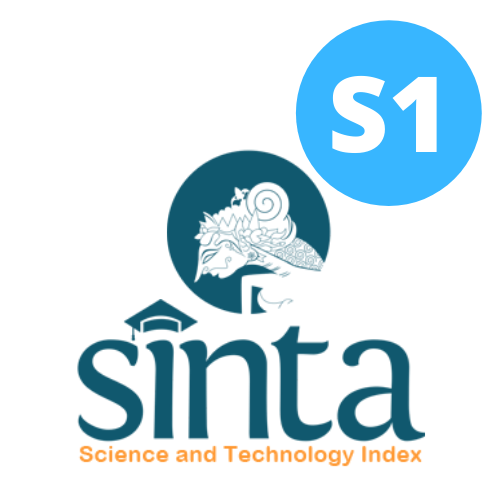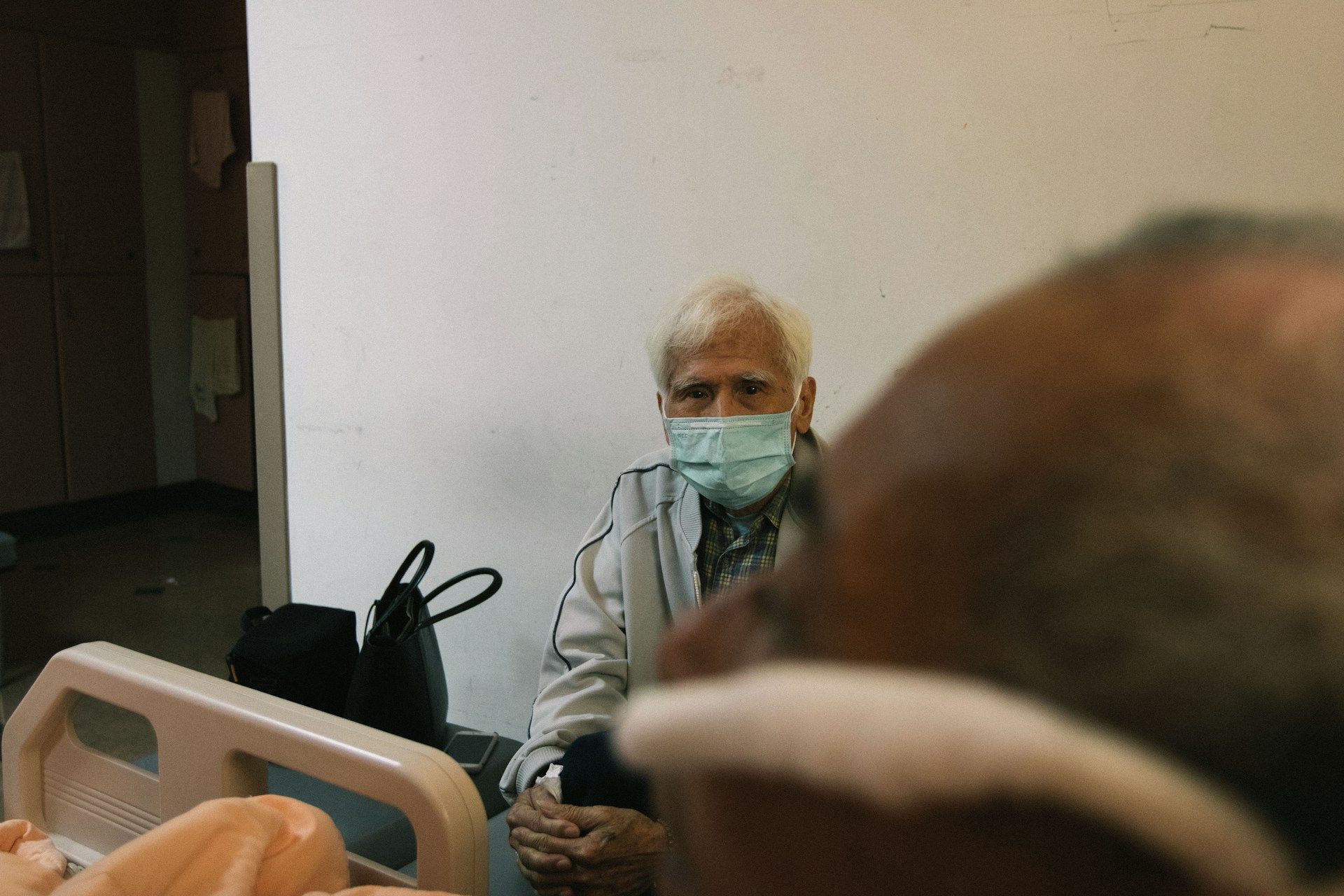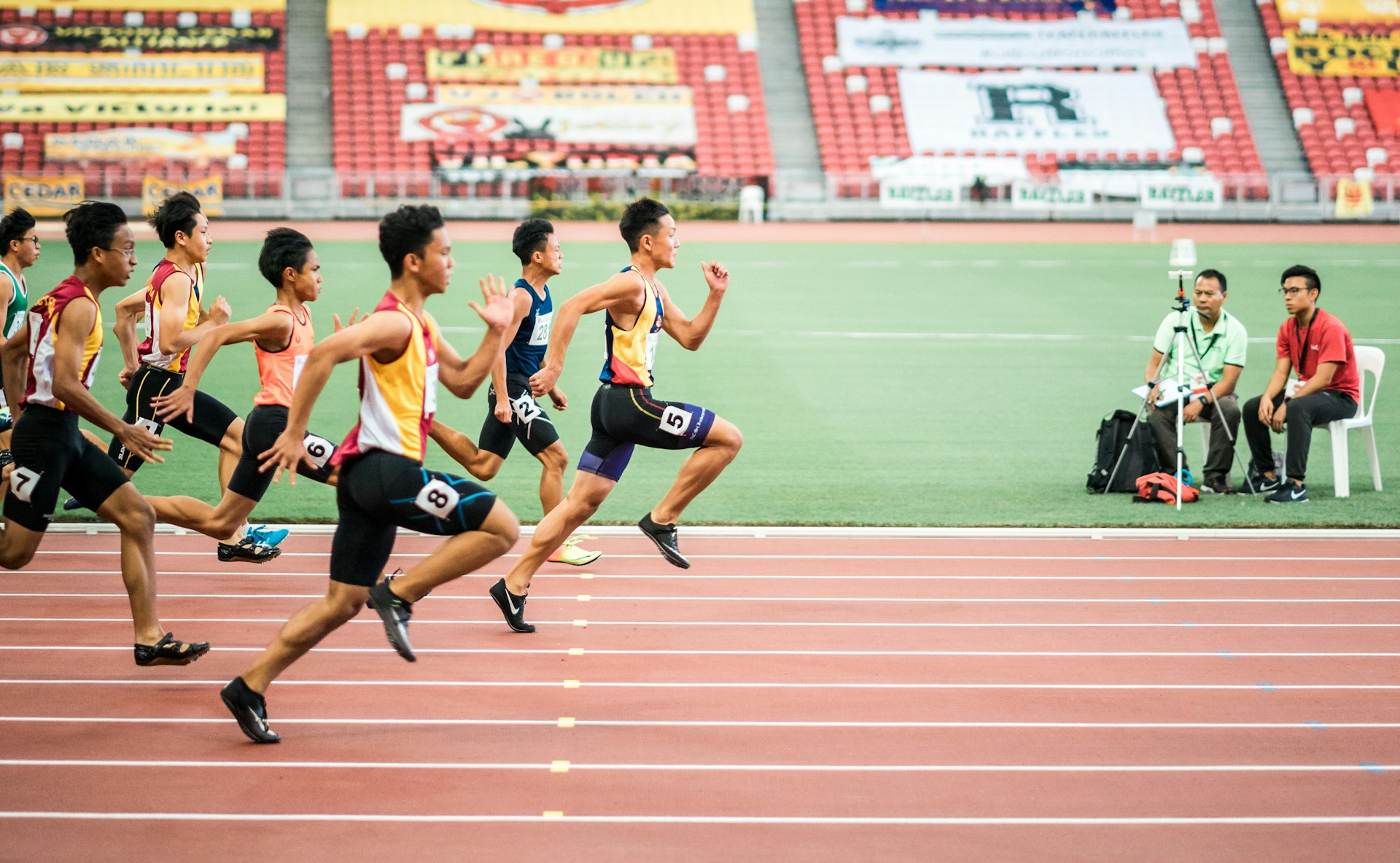The Relationship Physical Fitness with Learning Achievement of High School Students in Semarang
Hubungan Kebugaran Jasmani dengan Prestasi Belajar pada Siswa Sekolah Menengah Atas di Semarang

Downloads
Background: Many parents encourage their children to take additional lessons to enhance their academic performance, while other important aspects, such as students' physical fitness, are often overlooked.
Objectives: This research investigates the relationship between physical fitness and learning achievement among high school students in Semarang.
Methods: This observational study employed a cross-sectional design and involved 396 high school students in Semarang, with 86 subjects selected randomly. The dependent variable was learning achievement, measured by the raw scores of the final semester exams. The independent variable was physical fitness, while the other confounding variables included nutritional status, food consumption, socioeconomic conditions, health status, and participation in private tutoring. Dietary intake was assessed using a 24-hour food recall method. Body Mass Index for age (BMI/A) was calculated using weight and height to evaluate nutritional status. The multistage fitness test was utilized to assess physical fitness. Additional data were collected through interviews. Data analysis was conducted using chi-square tests and multiple logistic regression.
Results: The results indicated that most subjects had inadequate nutrient intake, with low percentages for energy (55.8%), carbohydrates (76.7%), protein (45.3%), and iron (64%). In contrast, fat intake was predominantly categorized as excessive (39.5%). While most subjects exhibited good nutritional status (79.1%), their physical fitness levels were primarily poor (58.1%). Multivariate analysis revealed that good physical fitness and participation in additional lessons were positively correlated with learning achievement (p-value=0.025, p-value=0.017).
Conclusions: Enhancing physical fitness is essential for improving student learning outcomes. Participating in supplementary activities, such as attending additional lessons, is also necessary to improve student learning achievement.
Irnani, H. & Sinaga, T. Pengaruh pendidikan gizi terhadap pengetahuan praktik gizi seimbang, dan status gizi pada anak sekolah dasar. J. Gizi Indones. The Indones. J. Nutr. 6, 58–64 (2017). https://doi.org/10.14710/jgi.6.1.58-64.
Sa’adah, R. H., Herman, R. B. & Sastri, S. Hubungan status gizi dengan prestasi belajar siswa Sekolah Dasar Negeri 01 Guguk Malintang Kota Padangpanjang. J. Kesehat. Andalas 3, 460–465 (2014). http://dx.doi.org/10.25077/jka.v3i3.176.
Suwandaru, C. & Hidayat, T. Hubungan aktivitas fisik dengan prestasi belajar siswa SMK Negeri 1 Surabaya. J. Pendidik. Olahraga dan Kesehat. V 09, 113–119 (2021). https://doi.org/10.31004/jrpp.v7i2.28340.
Sidabutar, H. A. Hubungan kebiasaan sarapan dan status gizi dengan prestasi belajar pada siswa SMA Negeri 17 Medan. Nutr. Nutr. Res. Dev. J. 03, 1–11 (2023). Available at: http://lib.unnes.ac.id/id/eprint/65375.
Kemendikbudristek. Peringkat Indonesia pada PISA 2022 Naik 5-6 Posisi Dibanding 2018. (2023). Available at: https://www.kemdikbud.go.id/main/blog/2023/12/peringkat-indonesia-pada-pisa-2022-naik-56-posisi-dibanding-2018.
Qodri, A. Teori belajar humanistik dalam meningkatkan prestasi belajar siswa. J. Pedagog. 04, 188–202 (2017). https://doi.org/10.33650/pjp.v4i2.17.
Salamah, M. S. & Setiawan, I. Tingkat kebugaran jasmani dan hasil belajar siswa dalam pembelajaran pendidikan jasmani olahraga dan kesehatan di SMP Negeri Kota Pekalongan. Indones. J. Phys. Educ. Sport 3, 439–448 (2022). http://dx.doi.org/10.15294/inapes.v3i2.60760.
Wadhani, L. P. P. & Yogeswara, I. B. A. Tingkat konsumsi zat besi (Fe), seng (Zn) dan status gizi serta hubungannya dengan prestasi belajar anak sekolah dasar. J. Gizi Indones. (The Indones. J. Nutr. 5, 82–87 (2017). https://doi.org/10.14710/jgi.5.2.82-87.
Mawarni, L. D. & Simanungkalit, S. F. Hubungan energi, protein, zat besi, dan pendapatan orang tua dengan prestasi belajar. Indones. J. Heal. Dev. 2, 163–174 (2020). https://doi.org/10.52021/ijhd.v2i3.62.
Mario. Faktor pendorong prestasi belajar peserta didik SD Makassar. J. Bhs. dan Pendidik. 3, 150–170 (2023). https://doi.org/10.47861/tuturan.v2i2.1072.
Erna, A., Natsir, M. S., Jailani, A. K., Wicaksono, Y. R. & Yusuf, P. N. Strategi analisis faktor - faktor penurunan prestasi belajar matematika dengan pendekatan data mining. J. Stud. Inov. 2, 17–23 (2022). http://dx.doi.org/10.52000/jsi.v2i4.122.
Hafiz, M. Al, Zulbahri, Rosmawati & Wulandari, I. Hubungan kebugaran jasmani dengan hasil belajar PJOK siswa kelas XI usia 16-17 tahun SMA Pembangunan Laboratorium UNP Kota Padang. J. Pendidik. dan Olahraga 7, 83–91 (2024). https://doi.org/10.24036/JPDO.7.2.2024.37.
Febriani, K. & Margawati, A. Hubungan asupan energi jajanan dengan prestasi belajar remaja di SMP PL Domenico Savio Semarang. J. Nutr. Coll. 2, 491–497 (2013). https://doi.org/10.14710/jnc.v2i4.3731.
Wijayasari, E. Y. T. Hubungan asupan zat gizi makro dengan prestasi belajar anak usia 16 - 18 tahun. (Universitas Muhammadiyah Yogyakarta, 2019). Available at: http://repository.umy.ac.id/handle/123456789/27519.
Sari, M., Sitoayu, L., Gifari, N., Nadiyah, N. & Nuzrina, R. Analisis asupan energi, zat gizi makro, vitamin c, zat besi, seng, dan IMT/U berdasarkan tingkat kognitif siswa kelas 5 di SD Negeri Duri Kepa 13 Pagi Jakarta Barat. Media Gizi Mikro Indones. 12, 39–52 (2020). https://doi.org/10.22435/MGMI.V12I1.2810.
Maku, A., Mendri, N. K. & Devianto, A. Hubungan antara status gizi dengan prestasi belajar anak sekolah dasar di SDN Ngringin Depok Sleman Yogyakarta. Caring J. Keperawatan 7, 1–8 (2018). http://dx.doi.org/10.29238/caring.v7i1.297.
Levina, A. & Sumarmi, S. Asupan zat gizi makro dan status gizi mahasiswa asing di Surabaya, Indonesia. Media Gizi Indones. 14, 132–139 (2019). https://doi.org/10.20473/mgi.v14i2.132-139.
Nugraha, M. H. & Wibowo, S. Hubungan antara status gizi dengan kebugaran jasmani. Pendidik. Jasm. Kesehat. Dan Rekreasi 09, 19–27 (2021). Available at: https://ejournal.unesa.ac.id/index.php/jurnal-pendidikan-jasmani/article/view/39782.
Kemenkes. Laporan Riskesdas 2018 Nasional.pdf. Lembaga Penerbit Balitbangkes hal 156 at (2018). Available at: https://repository.badankebijakan.kemkes.go.id/id/eprint/3514/.
Sahid, M. H., Adisasmita, A. C. & Djuwita, R. Hubungan status gizi dengan prestasi belajar siswa kelas 1-3 sekolah dasar. J. Epidemiol. Kesehat. Indones. 5, 75–82 (2021). https://doi.org/10.7454/epidkes.v5i2.2411.
Rizqi, H. & Ichwanudin. Hubungan asupan karbohidrat dan status gizi dengan tingkat kebugaran jasmani pada atlet basket remaja siswa sekolah menengah pertama. Media Gizi Indones. 11, 182–188 (2016). http://dx.doi.org/10.20473/mgi.v11i2.182-188.
Sari, K. Q. M. & Nurhayati, F. Hubungan antara status gizi, kecukupan asupan energi, dan aktivitas fisik dengan kebugaran jasmani pada siswa kelas XI di SMAN 1 Batu. J. Pendidik. Olahraga dan Kesehat. 6, 383–389 (2018). https://doi.org/10.14710/jnc.v10i3.30829.
Monzera, M. A., Ulfah, M. & Surahmi, F. Hubungan perilaku gaya hidup sehat terhadap kebugaran jasmani usia dewasa di fasilitas olahraga summit gym Kota Semarang. J. Updat. Keperawatan 2, 12–24 (2022). http://dx.doi.org/10.31983/juk.v2i2.8810.
Gunarsa, S. D. & Wibowo, S. Hubungan kualitas tidur dengan kebugaran jasmani siswa. J. Pendidik. Jasm. 09, 43–52 (2021). Available at: https://www.simantek.sciencemakarioz.org/index.php/JIK/article/view/495.
Aprilia, N. & Januarto, O. B. Hubungan kebugaran jasmani dengan prestasi belajar siswa SMP: literature review. Sport Sci. Heal. 4, 495–507 (2022). https://doi.org/10.17977/um062v4i62022p495-507.
Albi, M. W. & Rustiadi, T. Perilaku hidup sehat terhadap tingkat kesegaran jasmani siswa kelas XI IPA 2 SMA Negeri 9 Semarang T/A 2019/2020. Indones. J. Phys. Educ. Sport 2, 447–453 (2021). https://doi.org/10.31983/juk.v2i2.8810.
Gibson, R. . Principles of Nutritional Assessment. (Oxford University Press, 2005).
Muzakki, A. & Andrijanto, D. Survei tingkat kebugaran jasmani siswa saat pelajaran pendidikan jasmani olahraga dan kesehatan (PJOK) di SMP Daruttaqwa Gresik. J. Pendidik. Olahraga dan Kesehat. 09, 39–43 (2021). Available at: https://ejournal.unesa.ac.id/index.php/jurnal-pendidikan-jasmani/article/view/42704/36690.
Mulia, D. A., Amar, M. I., Sufyan, D. L. & Simanungkalit, S. F. Hubungan asupan energi dan protein, kualitas tidur, dan aktivitas fisik terhadap prestasi belajar di SMK Tunas Grafika Informatika 2020. Ghidza J. Gizi dan Kesehat. 5, 197–210 (2021). http://dx.doi.org/10.22487/ghidza.v5i2.216.
Almatsier, S. Prinsip dasar ilmu gizi. (PT Gramedia Pustaka Utama, 2005).
Amalia, T. P., Fadhilah, T. M. & Sartika, A. N. Hubungan asupan gizi dan stunting dengan prestasi akademik pada anak usia sekolah dasar di SDSN Jati Rahayu V Kota Bekasi. J. Gizi dan Pangan Soedirman 3, 90–98 (2019). https://doi.org/10.20884/1.jgps.2019.3.2.1652.
Fithria, Suhadi & Nelini. Hubungan kecukupan gizi sarapan dengan prestasi belajar siswa SMP Negeri 10 Kendari Kecamatan Kambu Kota Kendari tahun 2018. Prev. J. 3, 1–8 (2018). http://dx.doi.org/10.37887/epj.v3i1.5437.
Wadhani, L. P. P. & Wijaya, S. M. Konsumsi protein, vitamin a, dan status gizi serta kaitannya dengan hasil belajar anak sekolah dasar. J. Nutr. Coll. 10, 181–188 (2021). https://doi.org/10.14710/jnc.v10i3.30829.
Puspitasari, D. I., Hardiyanto, D. & Hamardika, N. A. Hubungan antara asupan zat besi dengan prestasi belajar siswa SMA Muhammadiyah 1 Surakarta. Darussalam Nutr. J. 5, 121–128 (2021). https://doi.org/10.21111/dnj.v5i2.6564.
Pratama, D. A. & Winarno, M. E. Hubungan status gizi dan kebugaran jasmani terhadap hasil belajar penjas siswa SMA: literature review. Sport Sci. Heal. 4, 238–249 (2022). http://dx.doi.org/10.17977/um062v4i32022p238-249.
Safitri, F. N. & Kustini, S. Pengaruh minat belajar, kondisi sosial ekonomi orang tua, dan lingkungan sekolah terhadap prestasi belajar ekonomi pada siswa kelas XI IPS SMA Negeri 4 Magelang tahun ajaran 2013/2014. Econ. Educ. Anal. Journa 3, 249–256 (2014). Available at: https://journal.unnes.ac.id/sju/eeaj/article/view/3865.
Nugroho, T. A. & Sudarma, K. Pengaruh gaya belajar, motivasi belajar, dan kondisi sosial ekonomi orang tua pada hasil belajar. Econ. Educ. Anal. J. 6, 188–201 (2017). http://dx.doi.org/10.31332/str.v26i2.2400.
Supit, D. & Gosal, N. M. Hubungan status sosial ekonomi orang tua dan prestasi belajar siswa. J. Educ. FKIP UNMA 9, 177–182 (2023). http://dx.doi.org/10.31949/educatio.v9i1.4557.
Dewi, R. & Marwan. Pengaruh faktor fisiologis, lingkungan sekolah, dan motivasi terhadap hasil belajar ekonomi di SMAN 2 Painan. EcoGen 2, 696–705 (2019). http://dx.doi.org/10.24036/jmpe.v2i4.7847.
Marlenywati, Hernawan, A. D. & Hardiyanti, A. D. Hubungan antara status gizi, kebiasaan sarapan pagi, aktivitas fisik, dan gangguan kesehatan dengan prestasi belajar anak sekolah dasar. Maj. Ilm. Al Ribaath 12, 16–23 (2015). http://dx.doi.org/10.29406/br.v12i2.82.
Amaliyah, M., Suardana, I. N. & Selamet, K. Analisis kesulitan belajar dan faktor-faktor penyebab kesulitan belajar IPA siswa SMP Negeri 4 Singaraja. J. Pendidik. dan Pembelajaran Sains 4, 90–101 (2021). https://doi.org/10.23887/jppsi.v4i1.33868.
Achmat, F. & Wahyuni, S. E. Hubungan kebugaran jasmani terhadap prestasi akademik siswa (studi pada kelas XI MAN Mojosari). J. Pendidik. Olahraga dan Kesehat. 1, 445–448 (2013).
Ristianti, A., Sukaesih, S. & Indriyanti, D. R. Hubungan bimbingan belajar swasta dengan hasil belajar biologi. Unnes J. Biol. Educ. 2, 196–204 (2013). https://doi.org/10.31004/jrpp.v7i2.26713.
Tarkuni. Pengaruh bimbingan belajar terhadap prestasi belajar siswa kelas V di sekolah dasar. Pedagog. J. Pendidik. dan Pembelajaran 1, 18–23 (2021). https://doi.org/10.56393/pedagogi.v1i1.78.
Subakti, H. & Handayani, E. S. Pengaruh bimbingan belajar terhadap hasil belajar bahasa indonesia siswa kelas tinggi di sekolah dasar. J. Basicedu 5, 247–255 (2021). https://doi.org/10.31004/basicedu.v5i1.648.
Copyright (c) 2025 Amerta Nutrition

This work is licensed under a Creative Commons Attribution-ShareAlike 4.0 International License.
AMERTA NUTR by Unair is licensed under a Creative Commons Attribution-ShareAlike 4.0 International License.
1. The journal allows the author to hold the copyright of the article without restrictions.
2. The journal allows the author(s) to retain publishing rights without restrictions
3. The legal formal aspect of journal publication accessibility refers to Creative Commons Attribution Share-Alike (CC BY-SA).
4. The Creative Commons Attribution Share-Alike (CC BY-SA) license allows re-distribution and re-use of a licensed work on the conditions that the creator is appropriately credited and that any derivative work is made available under "the same, similar or a compatible license”. Other than the conditions mentioned above, the editorial board is not responsible for copyright violation.












































